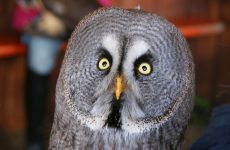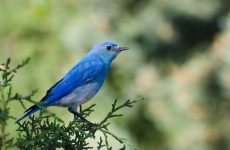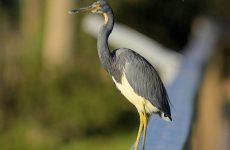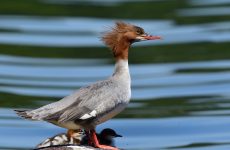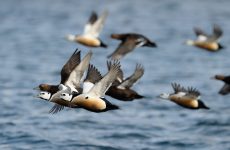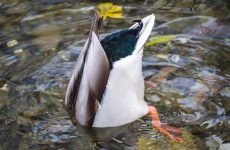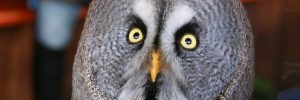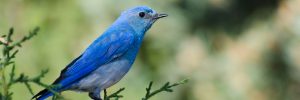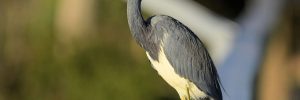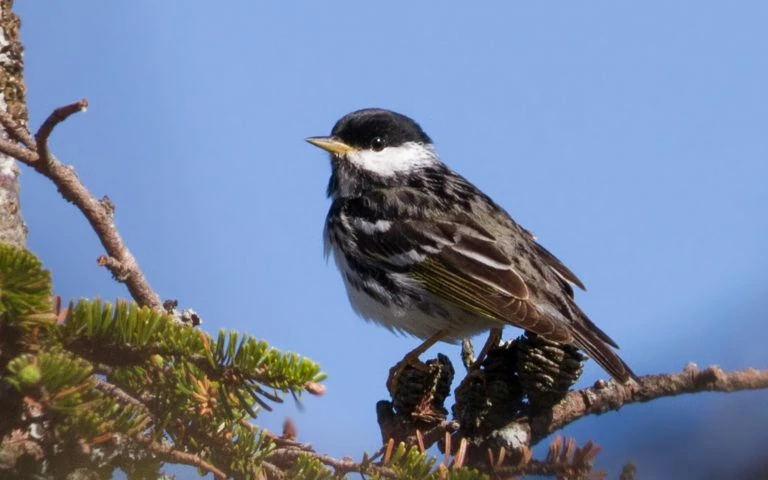
Do you need help identifying black-and-white birds that are visiting your backyard or are in the trees on your hike?
There are plenty of black-and-white birds that you can identify using this guide. Depending on light conditions and how far away a bird is it can be difficult to see if the bird is truly black or grayer or more blue in color.
I have included birds that may look black-and-white depending on the light conditions and how much time you get to observe them. They are predominantly black-and-white but some may have an additional color.
These are black-and-white birds that you can find in the US and Canada and I have included where they live to help with identification.
I hope this helps you identify some more birds.
34 Black and White Birds:
- Dark-eyed Junco
- White-breasted Nuthutch
- Black-and-White Warbler
- Yellow-rumped Warbler
- Blackpoll Warbler
- Black-throated Gray Warbler
- Black-billed Magpie
- Downy Woodpecker
- Hairy Woodpecker
- Red-bellied Woodpecker
- Red-headed Woodpecker
- Pileated Woodpecker
- Northern Flicker
- Yellow-bellied Sapsucker
- Red-naped Sapsucker
- Gila Woodpecker
- White-headed Woopecker
- Rose-breasted Grosbeak
- Spotted Towhee
- Eastern Towhee
- Black Phoebe
- Black-capped Chickadee
- Carolina Chickadee
- Tufted Titmouse
- Eastern Kingbird
- Loggerhead shrike
- Northern Mockingbird
- Barn Swallow
- Bushtit
- Blue-gray Gnatcatcher
- Eastern Wood Pewee
- Warbling Vireo
- Willow Flycatcher
- Black-crowned Heron
This site is reader-supported and as an Amazon Associate, I earn a commission if you purchase a product I recommend at no extra cost to you.
Dark-eyed Junco
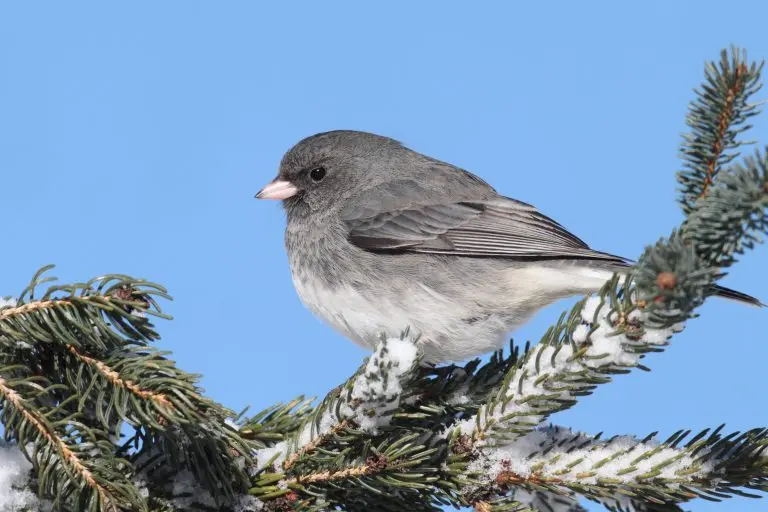
Dark-eyed Juncos are sparrows that are different colors depending on the state. They are generally slate-colored in the east and black, white, and brown in the west.
They can be found in open and partially wooded areas often on the ground and are common across the continent. Some remain resident all year in the west and in the Appalachian Mountains. Those that breed in Canada and Alaska migrate south in winter to most US states.
You can attract more Dark-eyed Juncos to backyard feeders with a variety of seeds such as black oil sunflower seeds, nyjer, cracked corn, millet, and peanuts. Platform feeders or scattered on the ground are best.
White-breasted Nuthutch
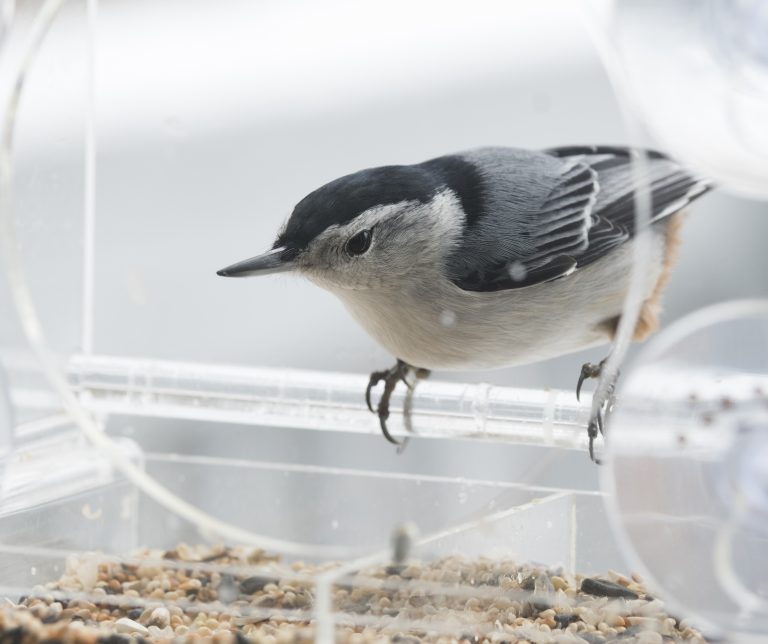
White-breasted Nuthatches are active little birds that are black, white, and gray. They are black and gray on the back, white underneath, and with a black cap. They will often have a chestnut color on the lower belly and under the tail.
White-breasted Nuthatches are common across the US and southern Canada.
They can be found in deciduous forests, woodland edges, parks, and yards with trees or at feeders. They mainly eat insects including beetles and their larvae, caterpillars, ants, and also spiders.
White-breasted Nuthatches also eat seeds and nuts including acorns, hawthorns, sunflower seeds, and sometimes corn crops. They jam large nuts and acorns into tree bark and then whack them with their bills to open or ‘hatch’ them to get the seed out.
You can attract more White-breasted Nuthatches to your backyard with sunflower seeds and peanuts on tube feeders or suet feeders.
Black-and-White Warbler
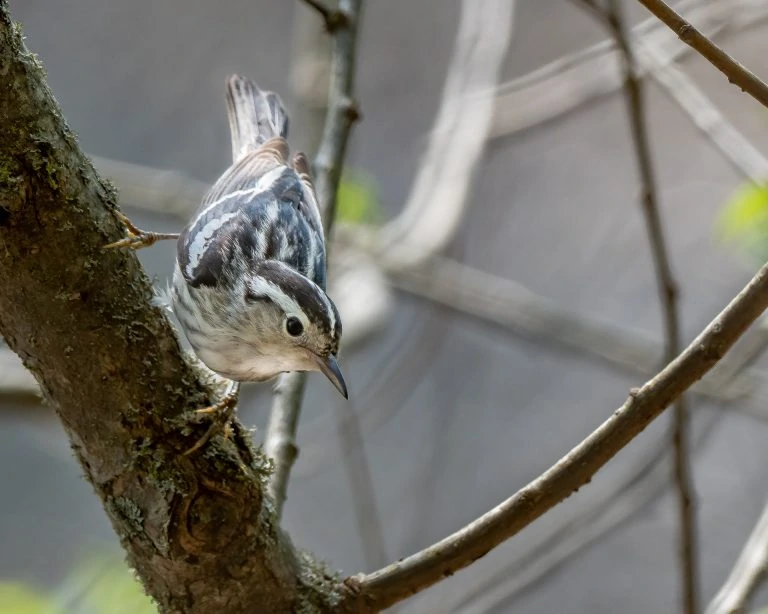
Black-and-white Warblers are quite distinctive and so more easy to identify with their stiped appearance.
Males have a larger black patch across the eye and cheek and are a darker black than females.
- Length: 4.3-5.1 in (11-13 cm)
- Weight: 0.3-0.5 oz (8-15 g)
- Wingspan: 7.1-8.7 in (18-22 cm)
Black-and-white Warblers spend the winter in Florida, along the Gulf Coast, and Down through Mexico, Baja California, the Caribbean, and into South America.
In spring they head north across the southwestern United States and along the border with Canada from east to west.
They are easy to spot hopping up and down on tree trunks and branches looking for insects.
Yellow-rumped Warbler
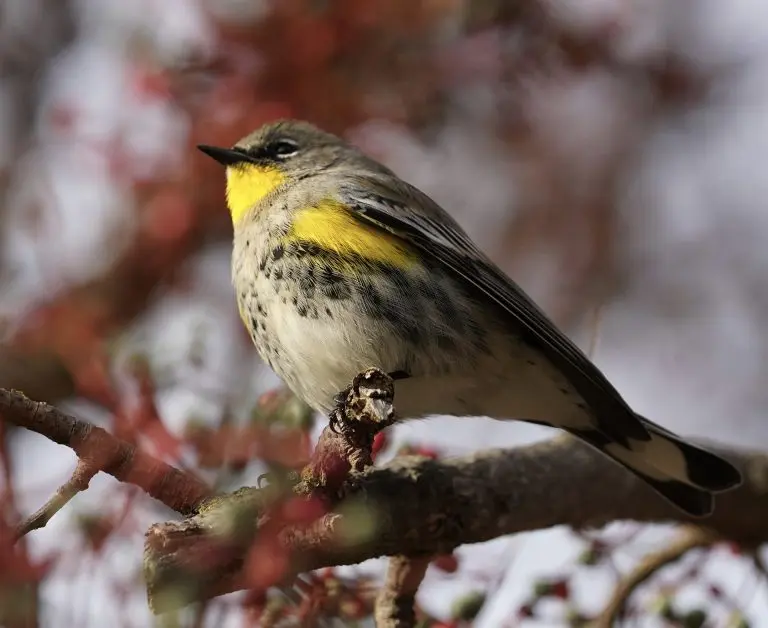
Yellow-rumped Warblers are gray with black streaks and white bellies. They have flashes of yellow on the face, sides, and rump and white in the wings. Females may be slightly brown and winter birds are paler brown with bright yellow rumps and sides turning bright yellow and gray again in spring.
After breeding predominantly in Canada they migrate in large numbers south across most of the southern and central states and the Pacific Coast and throughout Mexico and Central America.
- Length: 4.7-5.5 in (12-14 cm)
- Weight: 0.4-0.5 oz (12-13 g)
- Wingspan: 7.5-9.1 in (19-23 cm)
Yellow-rumped Warblers can be found in coniferous forests, especially during the breeding season, during winter they can be found in open areas with fruiting shrubs. In summer they eat mostly insects and on migration and in winter they mostly fruit including bayberry and wax myrtle.
You can attract Yellow-rumped Warblers to your backyard with sunflower seeds, suet, raisins, and peanut butter.
Blackpoll Warbler

Blackpoll Warblers are black-and-white with a black cap in the males. They look very different in late summer and molt into yellow with darker streaking on the back.
- Length: 5.5 in (14 cm)
- Weight: 0.4-0.5 oz (12-13 g)
- Wingspan: 8.3-9.1 in (21-23 cm)
Blackpoll Warblers breed in Canada and can be seen during spring migration in the Eastern US. In fall they migrate back without really stopping to their winter grounds in South America and the Caribbean. They make the journey over the Atlantic Ocean non-stop.
Feeding mostly on spiders and insects, Blackpoll Warblers will also eat fruit such as honeysuckle and pokeberry in the fall.
Black-throated Gray Warbler
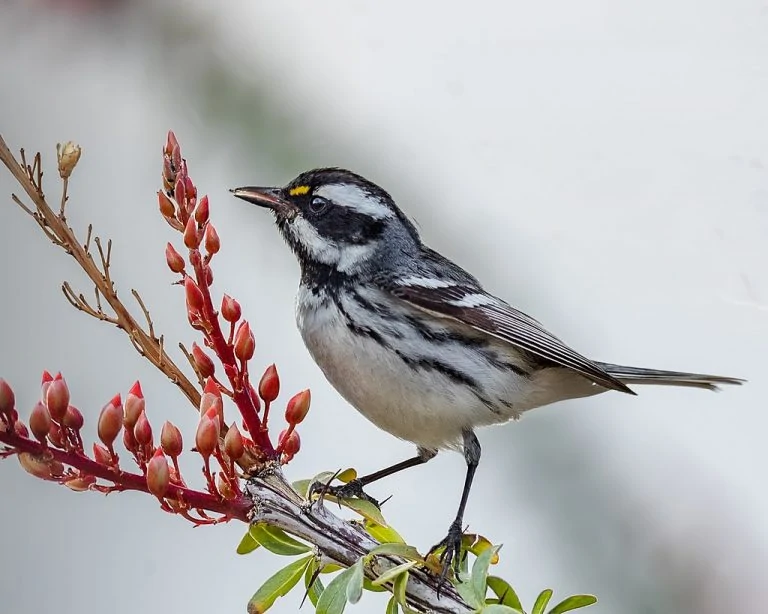
A black-and-white streaked warbler with a gray back and yellow spot in front of the eyes. Males have more black on their throats.
- Length: 4.3-5.1 in (11-13 cm)
- Weight: 0.3-0.3 oz (7-10 g)
- Wingspan: 7.5-7.8 in (19-19.7 cm)
Black-throated Gray Warblers breed in western US states and the coast of British Columbia before migrating to Mexico for winter.
They can be found searching for insects on trees in woodlands and on shrubs.
Black-billed Magpie
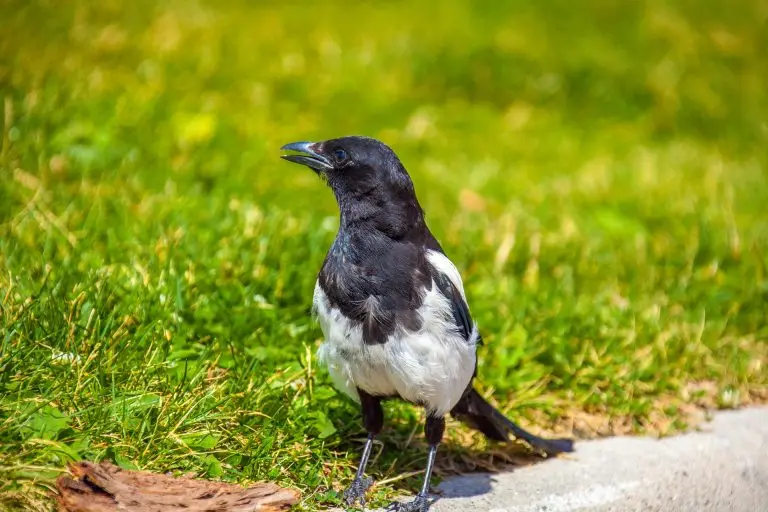
Black-billed Magpies are black and white birds that are noisy. They have long tails and blue-green iridescent flashes in the wing and tail.
- Length: 17.7-23.6 in (45-60 cm)
- Weight: 5.1-7.4 oz (145-210 g)
- Wingspan: 22.1-24.0 in (56-61 cm)
Black-billed Magpies live in northwestern US states and western Canada and the coast of Alaska. They do not migrate.
They can be found in meadow and grasslands or other open areas feeding on fruit and grain, beetles, and grasshoppers. They have also been known to kill small mammals such as squirrels and voles and raid bird nests for eggs or nestlings and even carrion.
Black-billed Magpies will visit backyards for platform and suet feeders with black oil sunflower seeds, peanuts, fruit, suet, millet, and milo.
Downy Woodpecker
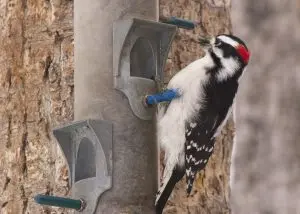
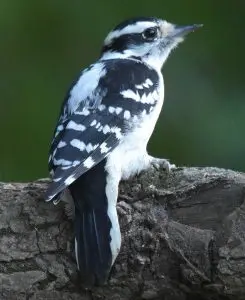
The Downy Woodpecker is the smallest woodpecker in North America.
- Length: 5.5-6.7 in (14-17 cm)
- Weight: 0.7-1.0 oz (21-28 g)
- Wingspan: 9.8-11.8 in (25-30 cm)
Although visually very similar to the Hairy Woodpecker it is a third smaller and with a smaller beak compared to other Woodpeckers. It is usually a Downy Woodpecker that you see at feeders as they are more common.
The Downy Woodpecker has black and white patterning, being mostly black with a white patch on their backs. The males also have a red patch on the back of their heads.
Downy Woodpeckers can be found on backyard bird feeders. They make a high-pitched pik sound and the descending whinny call and are very active so fun to watch. Downy Woodpeckers nest in dead tree cavities and lay between 3-8 small (0.8 in) white eggs
Downy woodpeckers eat mainly insects, especially larvae, nuts and they also eat berries, acorns, and grains. They will sometimes be seen drinking from hummingbird feeders.
How to attract more woodpeckers to your backyard:
An upside-down suet feeder is excellent for smaller woodpeckers such as Downy Woodpeckers as they offer protection from the rain and help stop bully birds. A bulk pack of suet cakes is a more economical way of buying them.
Also, black oil sunflower seeds attract more Downy Woodpeckers to your yard and if you combine them with suet in a great combination suet and hopper feeder then you get two feeders in one.
Hairy Woodpecker
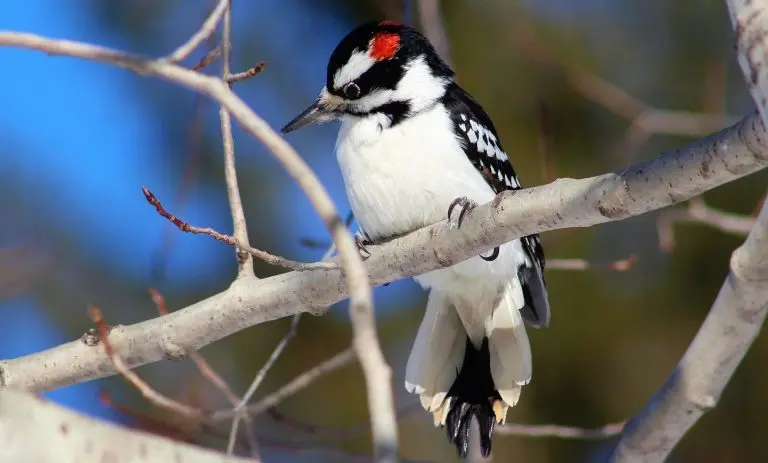
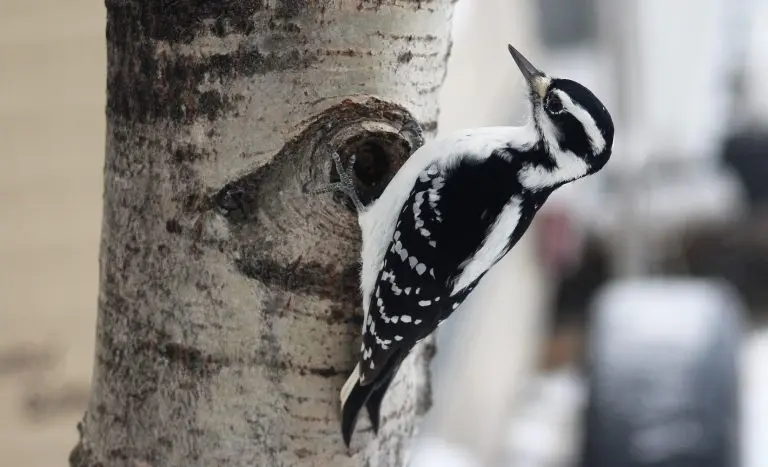
These medium-sized woodpeckers have a black and white pattern and a large white patch on their backs. The males have a flash of red towards the back of their heads.
Length: 7.1-10.2 in (18-26 cm)
Weight: 1.4-3.4 oz (40-95 g)
Wingspan: 13.0-16.1 in (33-41 cm)
It is visually similar to the Downy woodpecker but larger. As it is often found in the same areas it is hard to tell them apart. They can be seen on backyard feeders and are powerful small bird that makes a whinnying sound or explosive peak calls.
Hairy Woodpeckers’ diet is mostly insects such as beetle larvae, ants, and bark beetles but they will also eat bees, caterpillars, spiders, moth pupae, and millipedes.
This Woodpecker nests in the cavities of dead trees or dead parts of trees and lay between 3-6 white eggs.
Where to spot Hairy Woodpeckers:
You can find Hairy Woodpeckers in woodlands on trunks or main branches of large trees but they are also found in a wide variety of habitats including woodlots, parks, and cemeteries.
Red-bellied Woodpecker
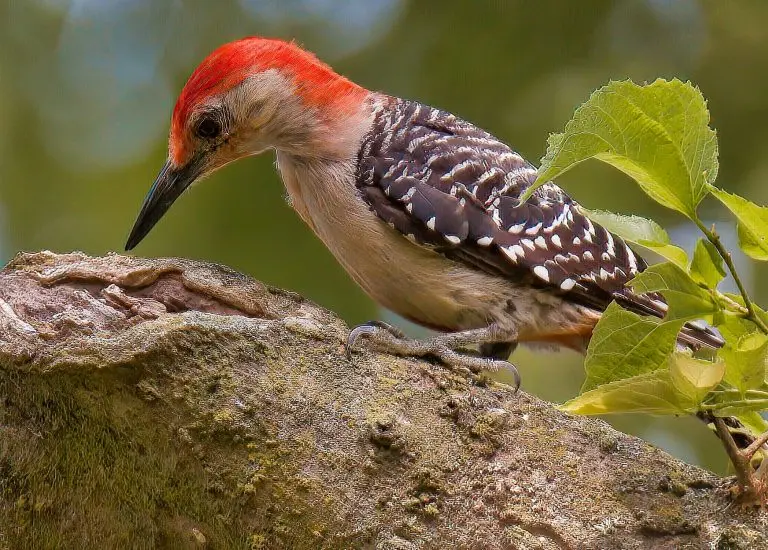
Red-bellied Woodpeckers can be mistaken for Red-headed Woodpeckers as they have red caps but this is much smaller than the Red-headed Woodpecker. Females lack the red cap and only have red napes.
Length: 9.4 in (24 cm)
Weight: 2.0-3.2 oz (56-91 g)
Wingspan: 13.0-16.5 in (33-42 cm)
They have a very pale red belly that can be hard to spot. They have the common black and white markings over their backs.
Red-bellied Woodpeckers can often be seen at bird feeders, especially if you live near wooded areas. They make a distinctive loud rolling call which means you will often hear them before you see them.
Red-bellied Woodpeckers eat insects, spiders, seeds from grasses, fruit, and nuts. They will also sometimes eat nestlings. They nest in dead trees and may use the same nest year after year. They lay 4-5 white eggs on a bed of wood chips.
The tongue of the Red-bellied Woodpecker sticks out 2 inches past the beak and is barbed at the tip and along with sticky spit, this helps catch prey from deep crevices.
Red-bellied Woodpeckers are common in woodlands and forests in the eastern US but can be seen on bird feeders.
Red-headed Woodpecker
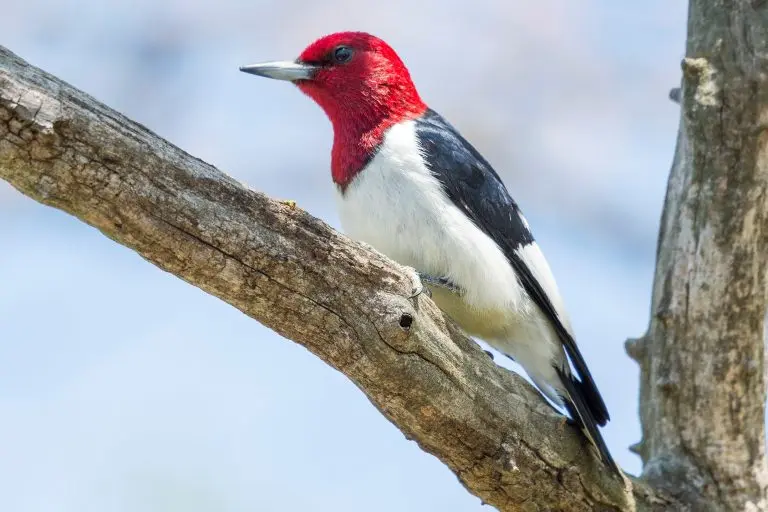
With their bright red-heads and black and white bold markings, these woodpeckers are one of the easiest to identify. Red-headed Woodpeckers are medium-sized with powerful spike bills. They have white undersides, black backs and large white bands on the wings, and short tails.
Length: 7.5-9.1 in (19-23 cm)
Weight: 2.0-3.2 oz (56-91 g)
Wingspan: 16.5 in (42 cm)
They can fiercely defend their territories, even removing or destroying the eggs of other birds or ducks. Red-headed Woodpeckers will catch insects in flight as well as in crevices like other woodpeckers.
Insects such as beetles, midges, honeybees, and grasshoppers, make up only about one-third of their diet. The other two-thirds are plant materials such as seeds, nuts, and berries. Red-headed Woodpeckers will also take nestlings or eggs from other birds and sometimes mice.
Red-headed Woodpeckers make a shrill call and nest in tree cavities sometimes reusing a site, and lay 4-5 white eggs. Unfortunately, huge declines of 70% of Red-headed Woodpeckers have occurred between 1966 to 2014 due to habitat loss.
Pileated Woodpecker
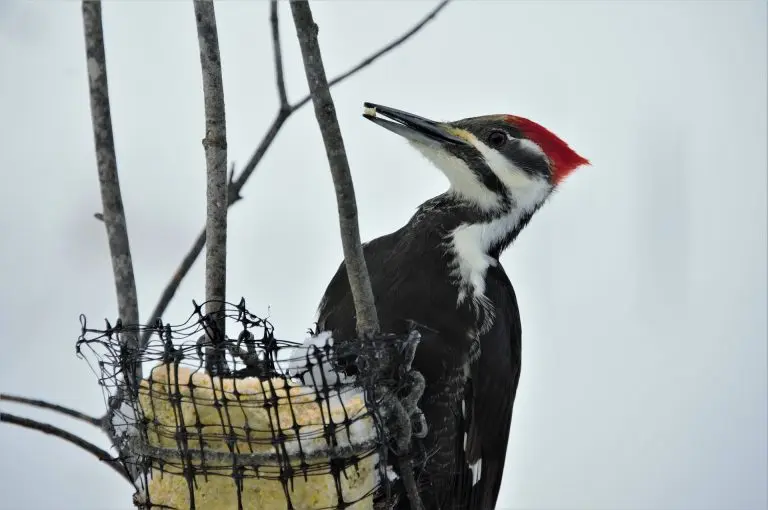
The Pileated Woodpecker is the biggest Woodpecker in the US. With its’ flaming-red triangular crest it is very striking.
Length: 15.8-19.3 in (40-49 cm)
Weight: 8.8-12.3 oz (250-350 g)
Wingspan: 26.0-29.5 in (66-75 cm)
It is one of the biggest woodpeckers being nearly the size of a crow. It is mostly black with a white strip and when flying the white underside of the wings can be seen. Males have an additional red stripe on the cheek.
Pileated Woodpeckers mostly eat carpenter ants from dead trees and fallen logs but they also eat beetle larvae, termites, and other insects as well as fruit and nuts such as blackberries, sumac berries, dogwood, and elderberry. They make a loud shrill, whinnying call and deep loud drumming.
Dead trees are used for nesting sites for Pileated Woodpeckers and they usually make a new one each year so the old nest site is often used by other species of birds. They usually lay 3-5 white eggs.
Where to spot Pileated Woodpeckers:
They are usually found in mature forests or drowned forests with lots of dead trees but they also visit backyard feeders especially for suet. They make distinctive rectangular holes in trees so look out for these.
How to attract more Pileated Woodpeckers to your backyard:
Pileated Woodpeckers come to backyard bird feeders, especially for suet. They also eat black oil sunflower seeds, hulled sunflower seeds, suet, peanuts, and mealworms. Also, try putting up a nest box to attract a breeding pair.
Pileated woodpeckers prefer suet feeders with tail props and enjoy suet with added mealworms.
Northern Flicker
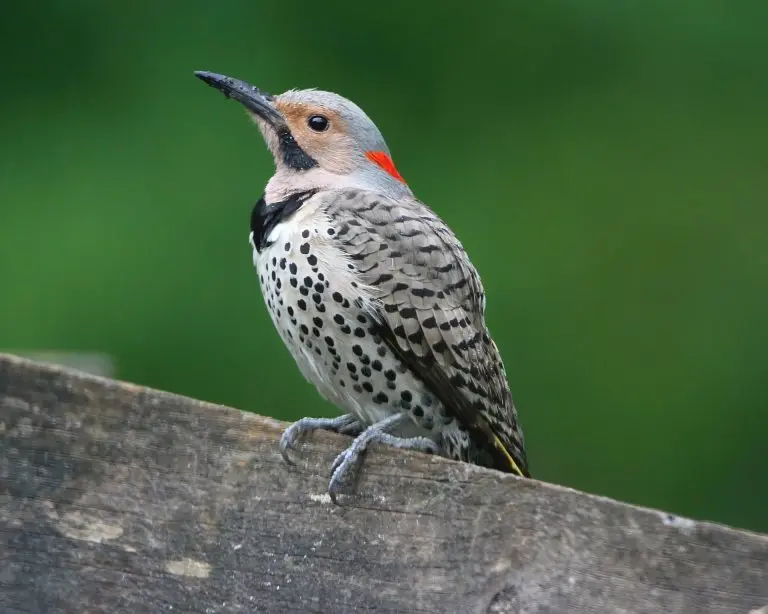
They are large brown woodpeckers with colorful black-spotted plumage, their bellies are more white with black spots..
In Texas, Northern Flickers have a flash of yellow in the wings and tails and a white patch on its rump in flight plus a red nape of the neck.
Length: 11.0-12.2 in (28-31 cm)
Weight: 3.9-5.6 oz (110-160 g)
Wingspan: 16.5-20.1 in (42-51 cm)
Northern Flickers make a loud ringing call with a piercing yelp. They nest in tree cavities and they lay 5-8 white eggs. They mainly eat ants and beetles but also fruits and seeds and can often be seen on the ground digging them up with their curved bill.
Where to spot Northern Flickers:
Northern Flickers can be seen in open woods, forest edges, and parks, and suburbs. They are often on the ground foraging for food.
How to attract more Northern Flickers to your backyard feeders:
Northern Flickers do come as often to bird feeders but they can be seen at a birdbath so adding an attractive pedestal birdbath or a heated birdbath for the winter is your best bet. You can try to encourage them by having black oil sunflower seeds, hulled sunflower seeds, safflower seeds, suet, cracked corn, peanuts, and millet on suet cages, large hoppers, or platform feeders.
You can also put up a nest box suitable for flickers to attract a breeding pair and plant berry-producing plants such as grape, bayberries, hackberries, or elderberries.
Yellow-bellied Sapsucker
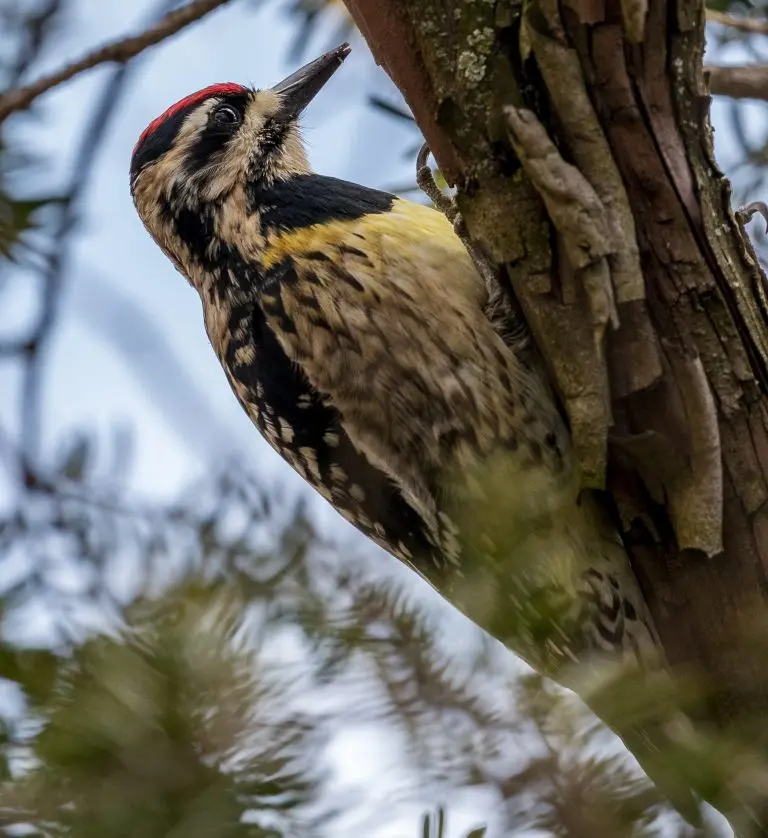
It is relatively small and is about the size of a robin. They are mostly black and white with red foreheads and the male has a red throat.
Length: 7.1-8.7 in (18-22 cm)
Weight: 1.5-1.9 oz (43-55 g)
Wingspan: 13.4-15.8 in (34-40 cm)
Yellow-bellied Sapsuckers make holes in trees and use their brush-tipped tongues to get the sap out. They make neat rows of holes in horizontal rows so look out for these in young paper birch, yellow birch, red or sugar maple, and hickory trees. The holes need to be maintained to ensure a flow of sap. They make a loud mewing call and they nest in tree cavities and usually have 5-6 white eggs.
Where to spot Yellow-bellied Sapsuckers:
Young deciduous forests often on birch or maple trees where they make neat rows of sapwells to feed.
How to attract more Yellow-bellied Sapsuckers to your backyard:
Although not usually found at bird feeders Yellow-bellied Sapsuckers sometimes will come for suet so try putting up squirrel-proof suet feeders and try mealworm suet or peanut butter suet.
Red-naped Sapsucker
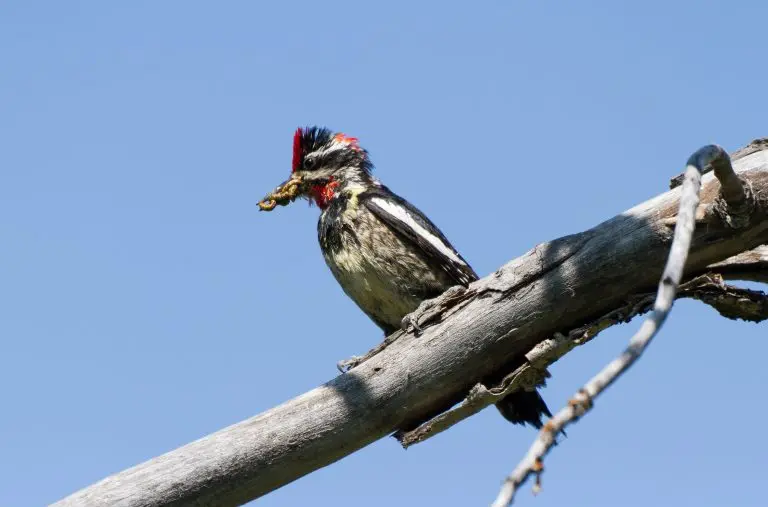
Red-naped Sapsuckers are medium-sized woodpeckers that look very similar to other woodpeckers and sapsuckers. A long white bar on the wings helps to distinguish them from the Hairy and Downy woodpeckers.
They are black and white with a red cap, nape, and throat and a black stripe through the eye with mottled bellies. Females are similar except for a white patch on the chin.
- Length: 7.5-8.3 in (19-21 cm)
- Weight: 1.1-2.3 oz (32-66 g)
- Wingspan: 16.1-16.9 in (41-43 cm)
Red-naped Sapsuckers are migratory and breed in mountain forests in western US states before migrating to southern Arizona, New Mexico, California, and Northern Mexico. They feed on sap by drilling parallel lines of holes and using their tongues to lap the sap rather than suck the sap. They also eat ants, spiders, beetles, and flies.
Like most woodpeckers, they build cavity nests in trees that have heartwood fungus making them softer and they may reuse the nest in future years and lay 3 – 7 eggs.
Gila Woodpecker
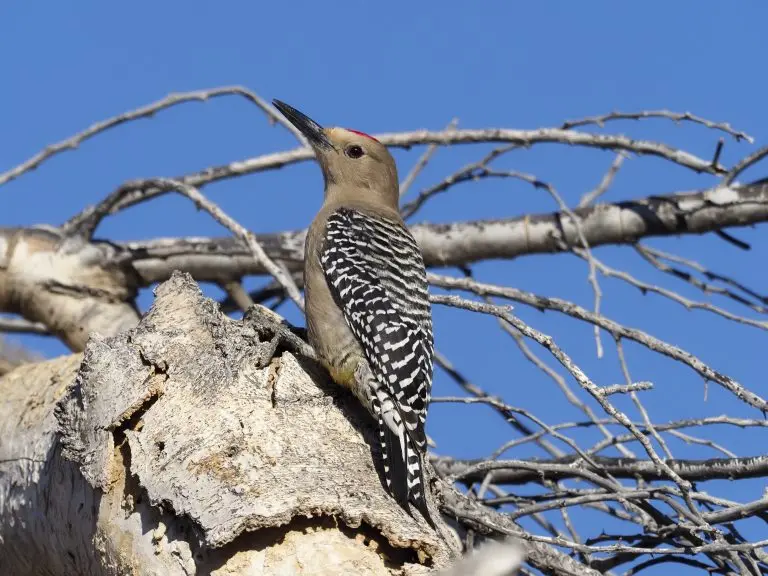
Gila Woodpeckers are barred black-and-white woodpeckers of the arid desert. They have tan heads and the males have a red crown patch.
They are resident in the arid deserts of the southwestern U.S, Northwest Mexico, and southern Baja California. They can often be seen and heard on a cool morning in their desert environment, often on top of a saguaro cactus.
Gila Woodpeckers feed on insects, small invertebrates, and berries. Usually foraging in cacti and dead vegetation and sometimes foraging on the ground for earthworms. They build their nests in excavated cavities in a saguaro cactus.
To attract Gila Woodpeckers try suet feeders and tube or platform feeders with corn, fruit, and nuts.
White-headed Woodpecker
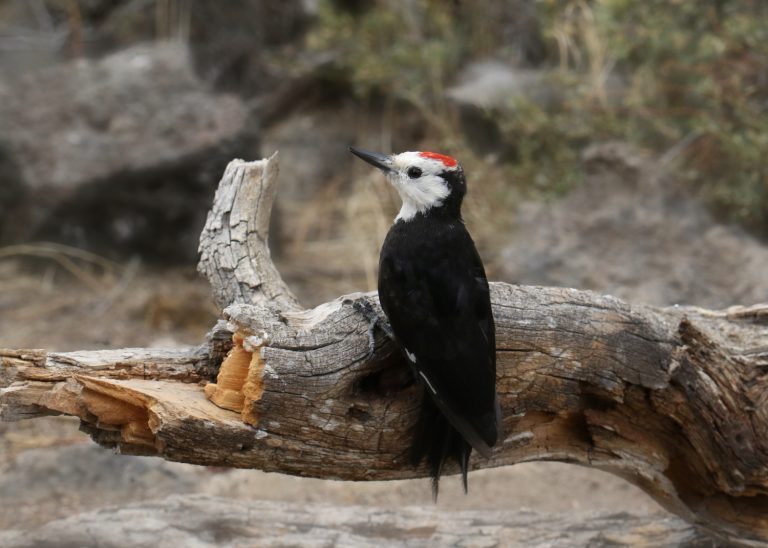
The white head and black body make the White-headed Woodpecker quite easy to identify. Males have a red patch toward the back of their head but females are only white and black. They have a white stripe on the wings when closed.
- Length: 8.3-9.1 in (21-23 cm)
- Weight: 1.9-2.3 oz (55-65 g)
Living in pine forests in western mountains from California to British Columbia eating pine seeds but also some insects, which they get from flaking the bark off rather than drilling holes like most woodpeckers.
Where to find White-headed Woodpeckers:
Forests with large ponderosa pine and sugar pine trees with large cones filled with pine seeds.
How to attract White-headed Woodpeckers to your yard:
Although they eat pine seeds they will also visit suet feeders if you live in their mountain range.
Rose-breasted Grosbeak
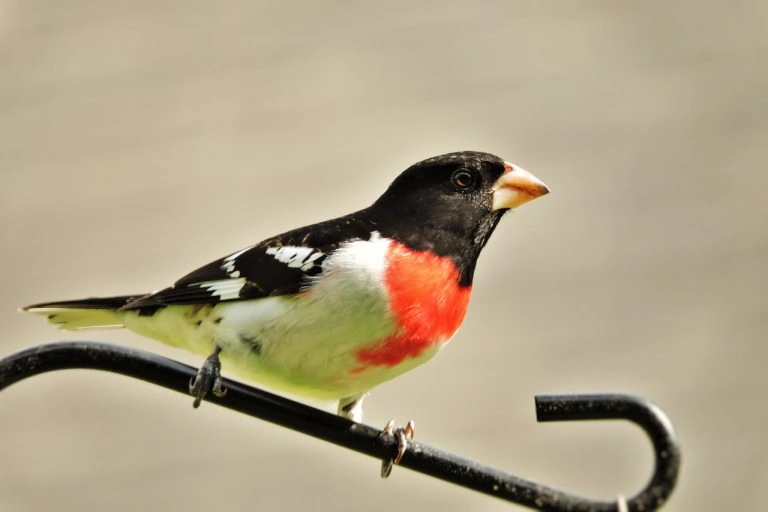
Rose-breasted Grosbeaks are distinctive birds that are a joy to see and easy to spot at your backyard feeders.
The males are black-and-white birds with black heads and back and white bellies, with a red breast. They also have a flash of red under the wings. Females and immature males are brown with lots of streaking and a flash of yellow under the wings.
Rose-breasted Grosbeaks breed in northeastern US states, the Midwest, and southern and central Canada. They can be seen during migration in the southeast. Winter is spent in Mexico, Central America, and the Caribbean.
Try putting out sunflower seeds and peanuts to attract more Rose-breasted Grosbeaks to your backyard.
Check out these articles if you want to know more about birds in North America:
- Backyard Birds in Every State – Free Picture ID Printable
- Hummingbirds in North America
- Birds with Red Heads
- Small Brown Birds
Spotted Towhee
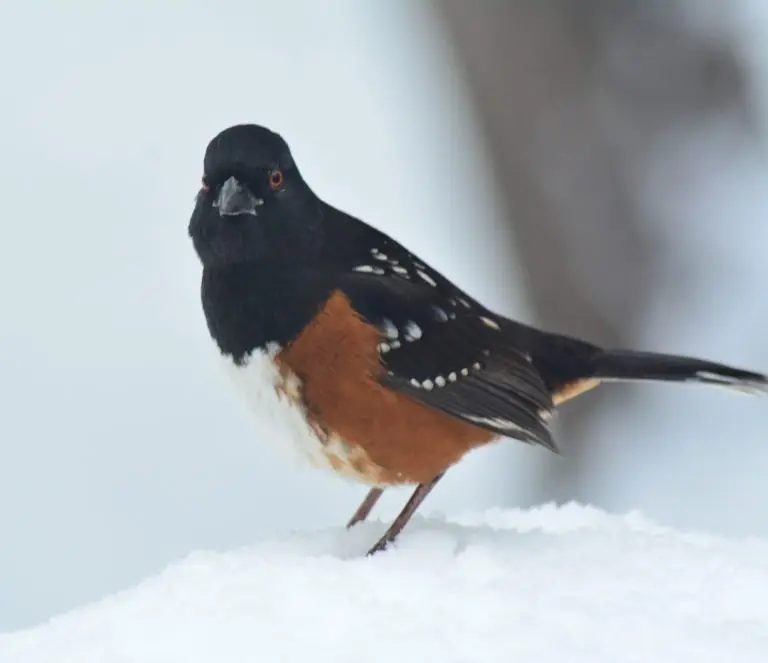
Spotted Towhees are large sparrows that are black on the head, throat, and back in the males and brown in the females. Both males and females have reddish-brown sides and white bellies and white spots on the wings and back. They have long tails and are about the size of a Robin.
Spotted Towhees can be found on the ground in dense tangles of shrubs scratching around for insects including beetles, crickets, grasshoppers, caterpillars, wasps, and bees. They also eat acorns, berries, and seeds.
They are resident on the Pacific coast but migrate from northern central states after breeding and appear in winter in a swath from north to south across all central states.
You can attract more Spotted Towhees to your yard if you leave overgrown borders and they will visit platform feeders or ground feeders for Black Oil Sunflower seeds, Hulled Sunflower seeds, Cracked Corn, Millet, and Milo.
Eastern Towhee
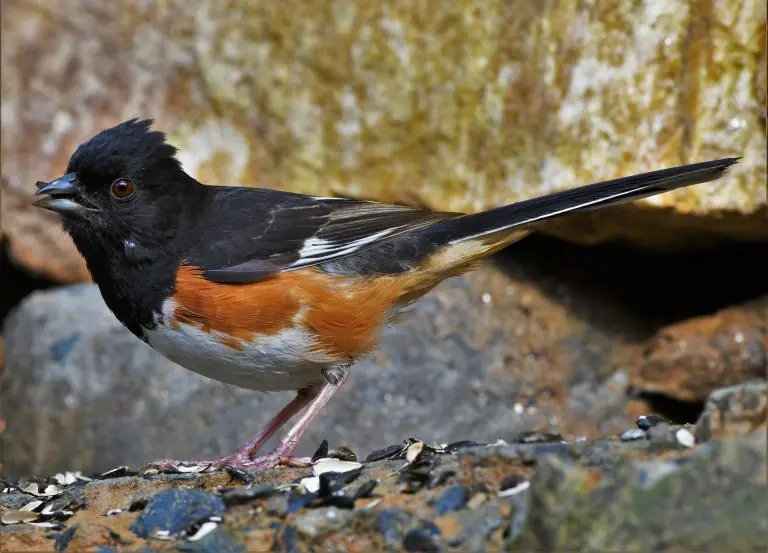
Eastern Towhees are striking large sparrows, about the size of Robin, with a black head, throat, and back, reddish sides, log tails, and a white belly in the males. The females are similar but with brown instead of black.
- Length: 6.8-8.2 in (17.3-20.8 cm)
- Weight: 1.1-1.8 oz (32-52 g)
- Wingspan: 7.9-11.0 in (20-28 cm)
Resident in southeastern states but birds further north move south for the winter and may only appear in winter on the western edge of their range.
Eastern Towhees spend their time rummaging in the undergrowth and can be found along the edges of forests and thickets.
Eastern Towhees visit feeders for fallen seed if your yard has overgrown borders and will also visit platform feeders for black oil sunflower seeds, hulled sunflower seeds, cracked corn, and millet.
Black Phoebe
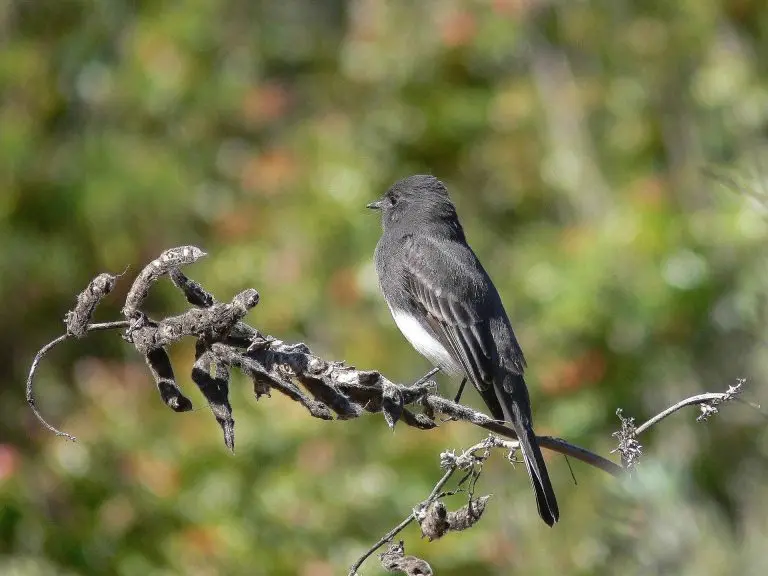
Black Phoebes are small, plump flycatchers that are black on the back, head, and chest and white underneath. They can look gray in some light.
- Length: 6.3 in (16 cm)
- Weight: 0.5-0.8 oz (15-22 g)
They are mostly resident across Southwestern States, Mexico, and Central America. Some in the north of this range may migrate south after breeding.
Black Phoebes can usually be found near water such as coastal areas, rivers, lakes, or ponds. They perch above the ground and wait for insects or arthropods to come along, such as beetles, grasshoppers, wasps, flies, bees, and spiders.
To attract Black Phoebes to your yard try adding water features and native plants to attract insects. They may also build a nest under the eaves if there is a source of mud nearby to build their nest out of.
Black-capped Chickadee
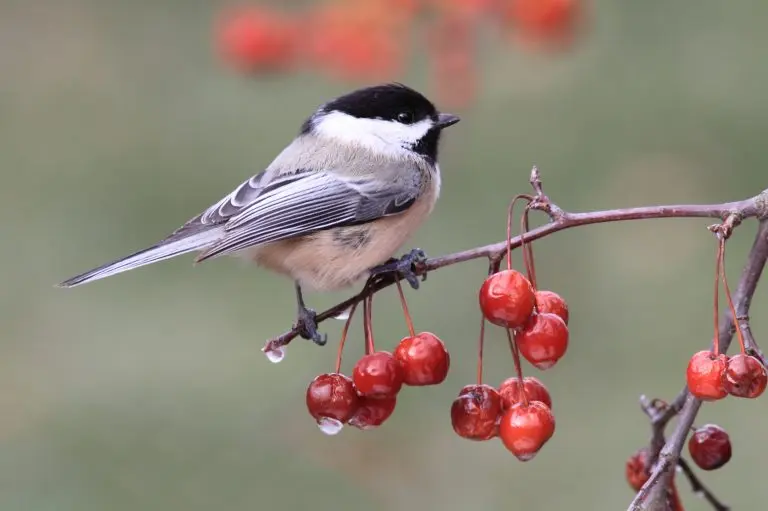
The Black-capped Chickadee is a cute bird with a big round head and tiny body. These birds will happily feed at backyard feeders and will investigate everything including you!
They have black caps and beaks, white cheeks, and are gray on the back, wings, and tail.
- Length: 4.7-5.9 in (12-15 cm)
- Weight: 0.3-0.5 oz (9-14 g)
- Wingspan: 6.3-8.3 in (16-21 cm)
Black-capped Chickadees live in the Northwest, Midwest, and Northern States and Canada all year.
They can be found in forests, open woods, parks. Black-capped Chickadees eat seeds, berries and insects, spiders, and suet.
To attract more Black-capped Chickadees to your backyard try suet, sunflower seeds, and peanuts or peanut butter. They will even feed from your hand and are often one of the first birds to discover new feeders. They will also use nest boxes, especially if you fill them with wood shavings.
Carolina Chickadee
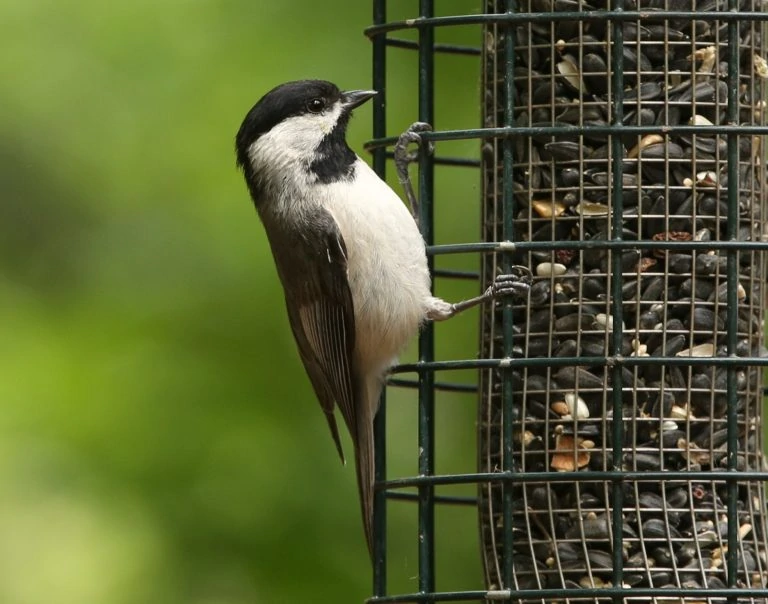
Carolina Chickadees are tiny birds with large heads, black cap and neck, white cheeks and belly, and soft gray back, wings, and tail.
- Length: 3.9-4.7 in (10-12 cm)
- Weight: 0.3-0.4 oz (8-12 g)
- Wingspan: 5.9-7.9 in (15-20 cm)
They are visually very similar to the Black-capped Chickadee and they interbreed where their range overlaps.
They can be found in forested areas, parks, and backyards in Eastern and Southeastern States all year.
You can attract more Carolina Chickadees to your backyard feeders with Black oil sunflower seeds, Nyjer seeds, suet feeders, or peanuts. They will feed on most types of feeders including tube feeders, suet cages, or platform feeders. They will also nest in nest boxes or nest tubes.
Tufted Titmouse
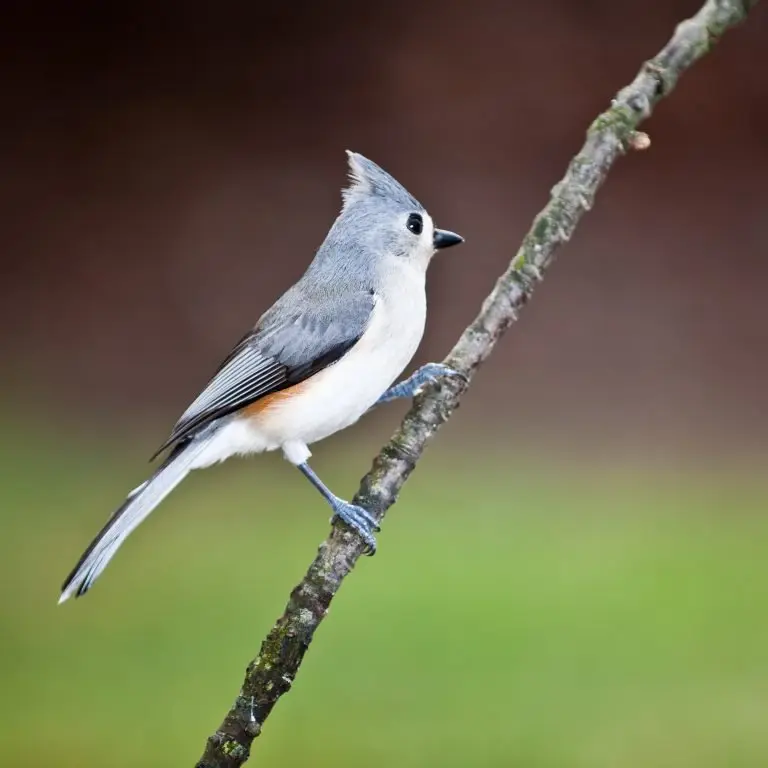
The Tufted Titmouse is gray on the back, with black edging to the wings and tail and white underneath with a cute gray crest and large eyes that often flock with chickadees, nuthatches, and woodpeckers.
- Length: 5.5-6.3 in (14-16 cm)
- Weight: 0.6-0.9 oz (18-26 g)
- Wingspan: 7.9-10.2 in (20-26 cm)
Tufted Titmice live in Eastern and Southeastern States all year
Tufted Titmice can be assertive over smaller birds and are found in woodlands, parks, and at backyard feeders. They eat mostly insects in summer including caterpillars, beetles, ants, and wasps as well as spiders and snails. They will also eat seeds, nuts, and berries and will hoard shelled seeds.
You can attract Tufted Titmice to your backyard feeders with sunflower seeds, suet, and peanuts on tube feeders or suet cages. They will also eat from platform feeders. You can also try putting up a nest box to attract a breeding pair.
Eastern Kingbird
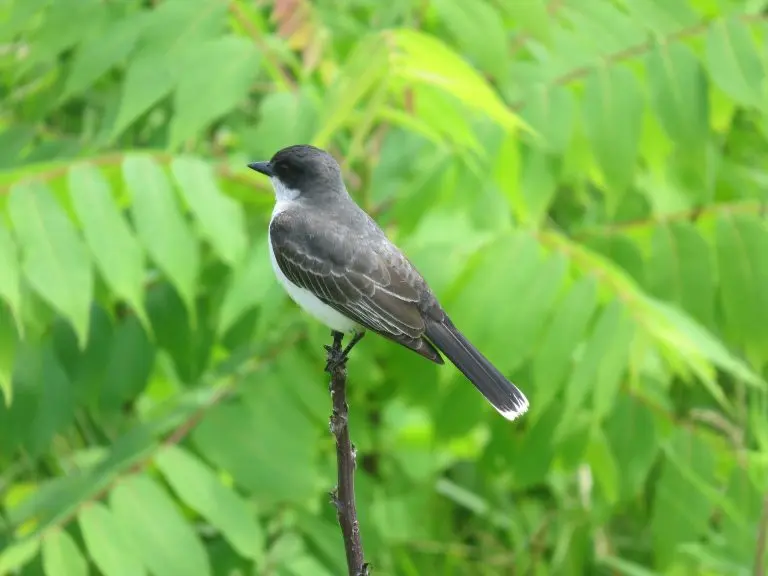
Eastern Kingbirds are medium-sized, large-headed flycatchers that are grayish-black on the back and white underneath. Their heads are darker black and they have a white tip on the tail.
- Length: 7.5-9.1 in (19-23 cm)
- Weight: 1.2-1.9 oz (33-55 g)
- Wingspan: 13.0-15.0 in (33-38 cm)
They get their name ‘king’ from the aggression they show each other and other birds when defending their nests.
They have a concealed crown, of yellow, orange, or red feathers, which they raise when defending themselves or their nest.
Eastern Kingbirds breed in most of the U.S except the Southwestern States, before heading south into Central and South America for winter. They usually breed in fields, orchards, and along forest edges. They can often be found nesting near water such as rivers or lakes.
Eastern Kingbirds catch insects in midair. They will often perch up above fields waiting for insects to fly past.
Check out these articles if you want to know more about birds in North America:
- Backyard Birds in Every State – Free Picture ID Printable
- Hummingbirds in North America
- Birds with Red Heads
- Small Brown Birds
Loggerhead Shrike
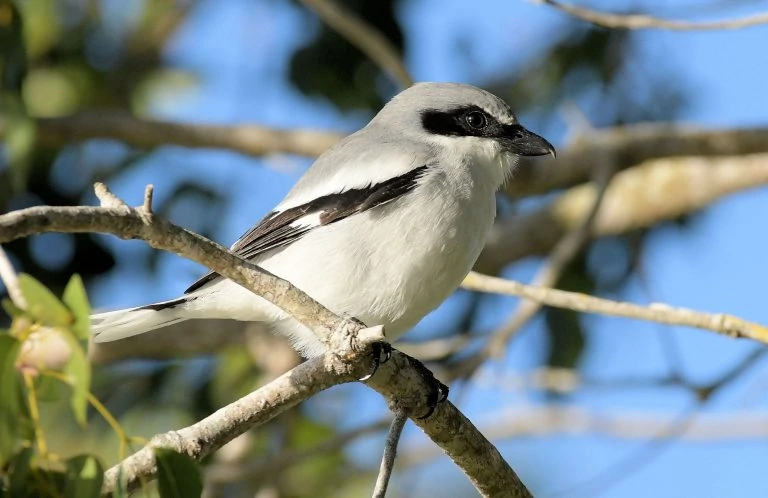
A songbird with the heart of a raptor, Loggerhead Shrikes are gray birds with a black mask and wings. They are white on their bellies.
- Length: 7.9-9.1 in (20-23 cm)
- Weight: 1.2-1.8 oz (35-50 g)
- Wingspan: 11.0-12.6 in (28-32 cm)
Loggerhead Shrikes live all year in the lower half of the US but will also travel north to breed in the summer before returning south.
The predatory gray birds hunt other birds, insects, lizards, and small mammals. They will skewer their prey on thorns or squeeze them into tight spaces to devour them.
They can be found in open habitats often perched watching for prey.
Northern Mockingbird
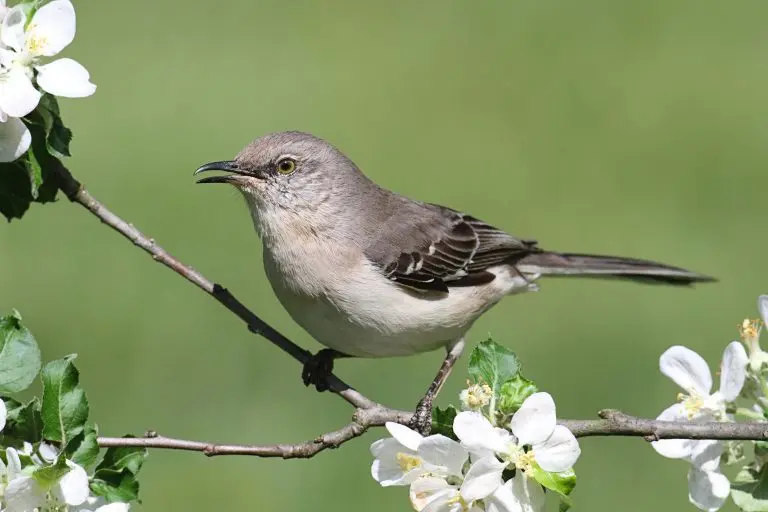
Northern Mockingbirds are medium-sized songbirds with small heads and long tails. They are a gray-brown color and white on their bellies. They have two white wingbars visible in flight.
They are usually seen alone or in pairs and aggressively defend their territory. A male mockingbird can learn around 200 songs in its life, copying other birds’ songs and they can sing all through the day and into the night.
Residents in southern and eastern states but may migrate from the north of their range.
They don’t often visit feeders but will come to open lawn areas. To attract more Northern Mockingbirds try planting fruiting trees or bushes, including hawthorns, mulberries, and blackberry brambles.
Barn Swallow
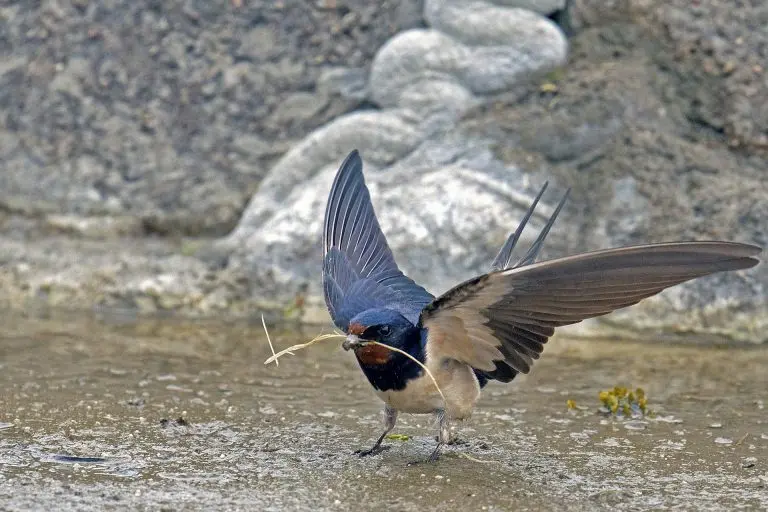
Barn Swallows are small birds with a deep-blue back, wings and tail, and reddish-brown underneath and across the face. The tail has long outer feathers that give a deep fork. The dark color of the back can make them look black-and-white.
- Length: 5.9-7.5 in (15-19 cm)
- Weight: 0.6-0.7 oz (17-20 g)
- Wingspan: 11.4-12.6 in (29-32 cm)
They breed over most of North America before heading to Central and South America. They can be found flying over meadows, farms, and fields looking for insects and usually build mud nests on man-made structures such as in barns.
You can attract more Barn Swallows by putting up nest boxes or cups and may eat ground-up eggshells on a platform feeder.
Bushtit
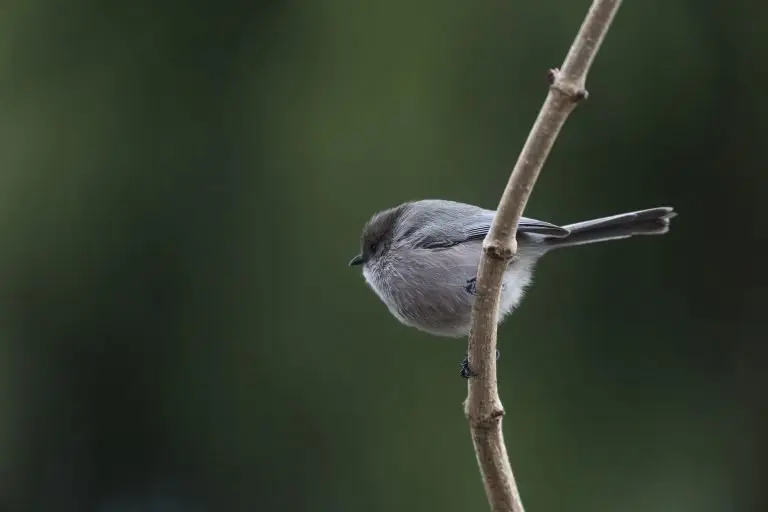
Bushtits are tiny, almost round, soft gray birds with a long tail and stubby bill. They have slight brown tinges to the face and underneath. They have dark almost black heads white on the lower belly.
- Length: 2.8-3.1 in (7-8 cm)
- Weight: 0.1-0.2 oz (4-6 g)
Bushtits live all year in the Western States.
They can be found in open woodland or scrubby areas, parks, and backyards. Their diet is insects and spiders, such as caterpillars, beetle, wasps, and ants.
Bushtits make amazing hanging nests out of plant material and spider webs that hang down about a foot and may take a month to build.
To attract more bushtits to your yard plant native shrubs and trees and they may visit feeders filled with black oil sunflower seeds, suet, or mealworms from platform feeders.
Blue-gray Gnatcatcher
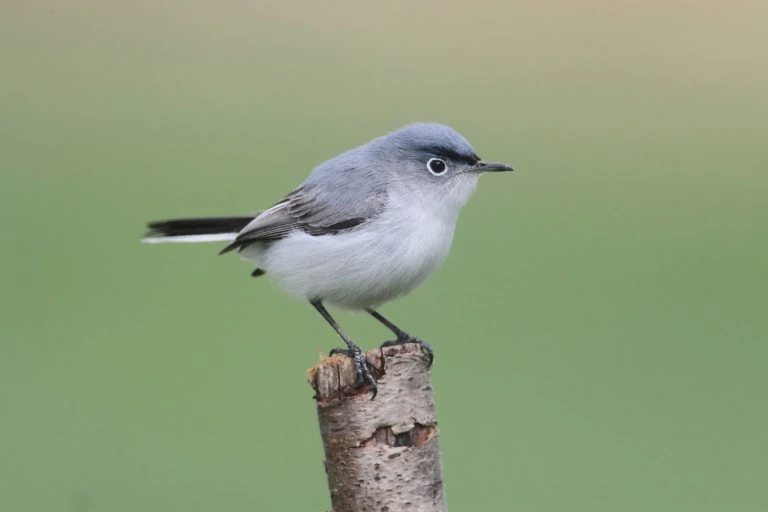
Blue-gray Gnatcatchers are tiny songbirds with a soft blue-gray color on the back and grayish-white underneath. They have a black tail and patches on their wings. Males have a distinctive black ‘V’ shape on their foreheads in summer.
They have long tails and legs and small, thin, straight bills.
- Length: 3.9-4.3 in (10-11 cm)
- Weight: 0.2-0.3 oz (4.8-8.9 g)
- Wingspan: 6.3 in (16 cm)
Blue-gray Gnatcatchers breed in deciduous forests in the Southern and Eastern States before heading south. They do also remain all year in Florida and along southern coastal areas.
Nests of Blue-gray Gnatcatchers look similar to hummingbird nests as they are small and built onto branches so they look like a tree knot covered in lichen.
Feeding on insects and spiders by constantly hopping around and scaring them by flicking their tail up and down.
Eastern Wood Pewee
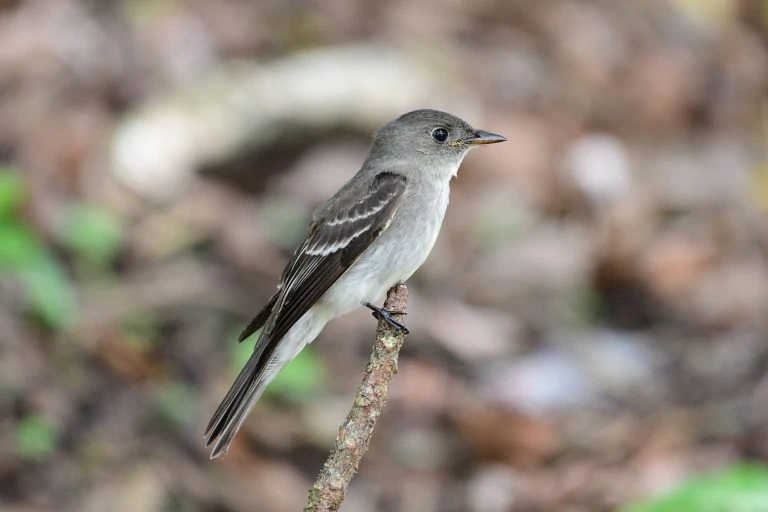
Named after the call they make, the Eastern Wood-Pewee is an unassuming dark gray flycatcher with off-white undersides and almost black streaks in the wings.
- Length: 5.9 in (15 cm)
- Weight: 0.3-0.7 oz (10-19 g)
- Wingspan: 9.1-10.2 in (23-26 cm)
Arriving later than most birds from overwintering in South America, the Eastern Wood-Pewee breeds over eastern states and into Canada.
They can often be found perched on exposed branches in forests watching for their prey of small flying insects.
Warbling Vireo
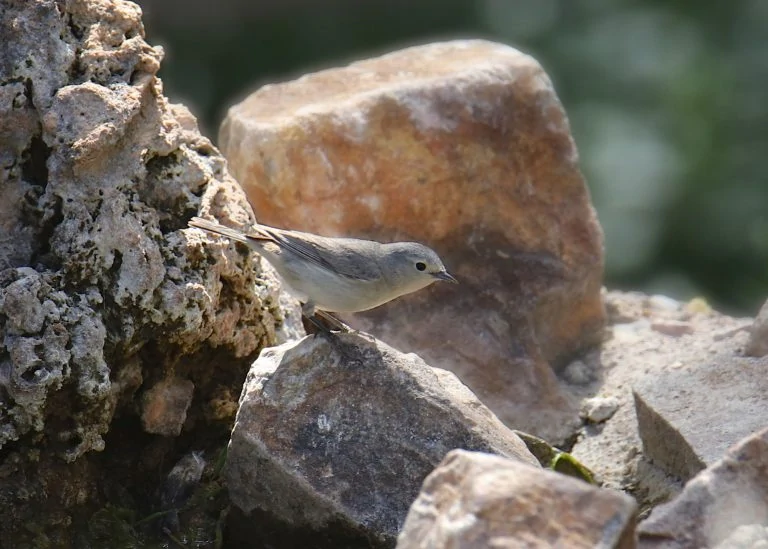
Warbling Vireos are gray and olive birds and lighter whiteish-yellow underneath.
- Length: 4.7-5.1 in (12-13 cm)
- Weight: 0.3-0.6 oz (10-16 g)
- Wingspan: 8.7 in (22 cm)
Warbling Vireos breed over most of the US and into northwestern Canada, except the Gulf Coast. They spend winter in Mexico and Central America.
They can be difficult to find as they stay high up in the trees.
Willow Flycatcher
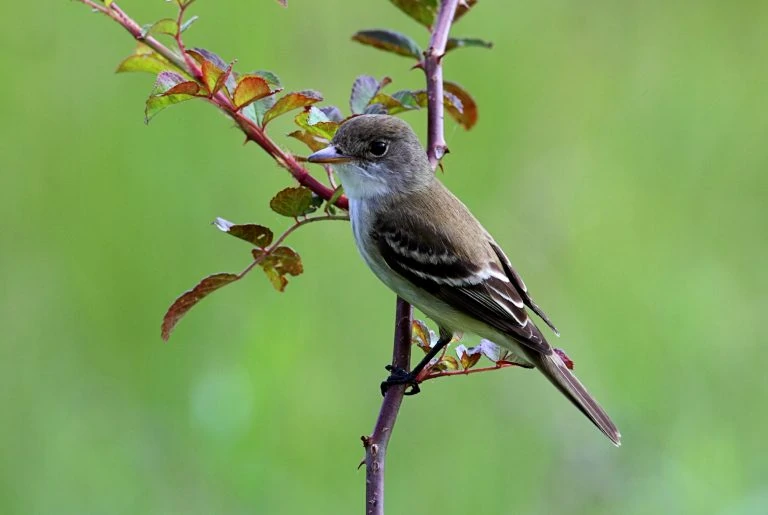
Willow Flycatchers are grayish-brown and with olive tones. Their bellies are gray with yellow tones.
- Length: 5.1-6.7 in (13-17 cm)
- Weight: 0.4-0.6 oz (11-16 g)
- Wingspan: 7.5-9.4 in (19-24 cm)
Willow Flycatchers breed in northwestern states and meadows of the mountainous west before heading to Mexico and Central America. They can also be seen during migration over all US states.
Black-crowned Heron
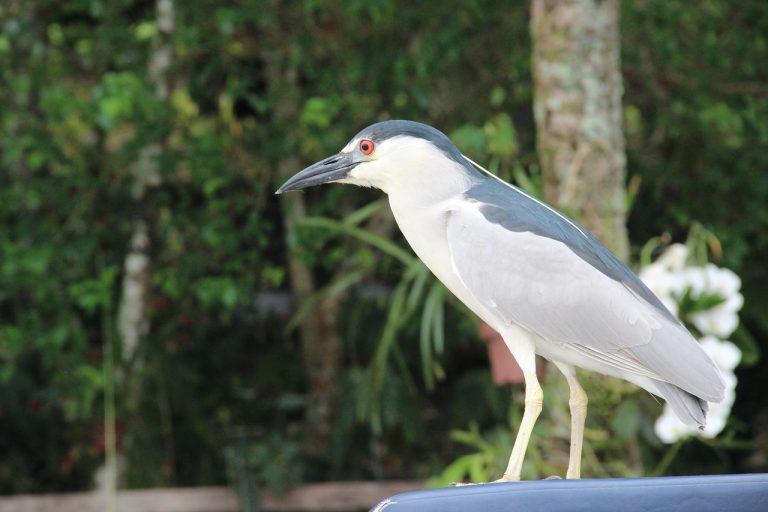
Black-crowned Night Herons are black on the back and crown, white underneath and with grey sides. They are quite small for herons.
- Length: 22.8-26.0 in (58-66 cm)
- Weight: 25.6-35.8 oz (727-1014 g)
- Wingspan: 45.3-46.5 in (115-118 cm)
They can be found perched on branches during the day and out hunting near wetlands and mudflats at night.
Black-crowned Herons breed in most US states and into central Canada before heading south to Mexico and Central America. Some remain all year along coastal areas or along the Mississippi.
Check out these articles if you want to know more about birds in North America:

